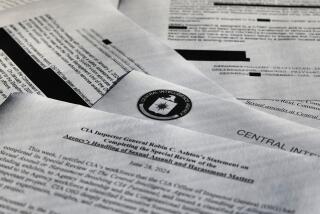Tailhook Helped Steer Navy to New Course on Sex Abuse
- Share via
WASHINGTON — As the Navy begins to close its books on the Tailhook scandal--with seemingly little to show for it in terms of formal prosecutions and punishments--critics are asking whether the worst such episode in modern naval history was all for naught.
Although the initial investigation concluded that 83 women had been assaulted or molested--and more than 140 officers had engaged in misconduct--at the now-infamous Las Vegas convention of naval aviators in 1991, none of the resulting trials has produced a conviction.
And Lt. Paula Coughlin, the Navy pilot whose complaints helped thrust the scandal onto the nation’s front pages, has resigned in despair, saying she has been subjected to “covert and overt attacks” from colleagues ever since she reported the incident.
But a closer look suggests that the Tailhook scandal has indeed had a profound impact on the status of women in the Navy and is likely to prove a watershed in prodding the Navy to reverse course on the issue of sexual harassment.
Despite the low score card on courts-martial convictions--the result of a variety of legal difficulties--the Tailhook affair has ended hopes for promotion (and thus ruined the careers) of dozens of officers--a signal that, in Navy terms, is as clear as a court-martial conviction.
For all of its initial hesitation, the Navy hierarchy has moved quickly to change attitudes within the service.
Last year’s widely publicized Navy sensitivity training detailing red, orange and green zones for proper behavior was ridiculed by civilians, but officials say it has worked reasonably well to help sailors define what constitutes sexual harassment under the new rules.
And the Navy has opened up a plethora of jobs--such as combat aviation--to women. On orders from Navy Secretary John H. Dalton, the admirals are scrambling to integrate women into the crews of aircraft carriers and destroyers--some of them eventually as skippers.
Interviews with female officers and sailors over the last few months suggest that the changes have been so fundamental that they qualify as something of a social revolution in the Navy.
Cmdr. Deborah Branson, a veteran naval aviator who had been frustrated over the treatment of Navy women, calls the changes stunning and credits the impact of Tailhook for bringing them about so quickly.
“Women today are out there doing the job,” she says, referring to the recent decision by the top Navy leadership to accept women in career-enhancing combat assignments. Without Tailhook, she contends, “it wouldn’t have happened as fast.”
Lawrence J. Korb, a Brookings Institution analyst who served as assistant secretary of defense for manpower issues, agrees. “I think women in the Navy came out ahead because of Tailhook,” Korb asserts. “I don’t think the Navy would have acted as quickly without it.”
Korb argues that change in the sea service often follows a pattern: initial recalcitrance, followed by a striking turnaround in policy. It did the same on such issues as integrating blacks, closing unneeded naval bases and devising a strategy for the post-Cold War world.
To be sure, the Navy has not eliminated bias against women in its ranks. They still are prohibited from serving on certain vessels--such as submarines. And everyone is not fully on board when it comes to accepting women as equals.
During a recent hearing of the House Armed Services Committee, women in all four armed services told of instances in which they were subjected to sexual harassment, only to find that they--rather than the offenders--were punished.
But in a sign of the Navy’s altered course, Assistant Secretary of Defense Edwin Dorn apologized immediately after the women testified, admitting that “some egregious cases of sexual harassment have been handled incompetently.”
More to Read
Sign up for Essential California
The most important California stories and recommendations in your inbox every morning.
You may occasionally receive promotional content from the Los Angeles Times.













